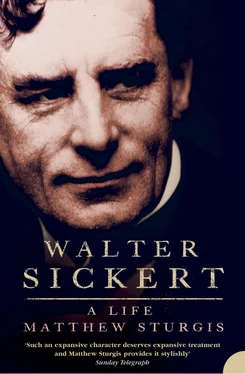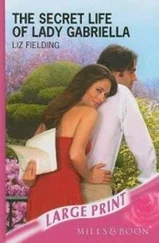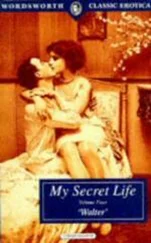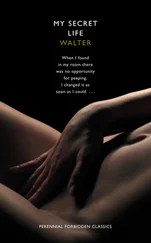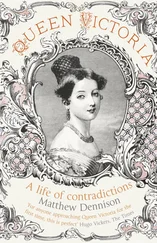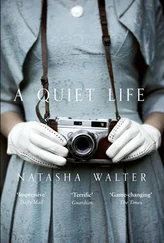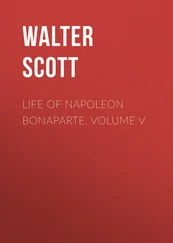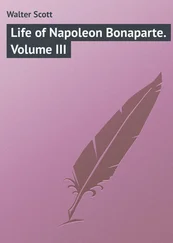Although he admired Bryan’s dashing if rather facile work, and that of several other black-and-white men, his great enthusiasm was for the drawing of Charles Keene. Since 1850, Keene had been one of the leading draughtsmen on Punch . His assured but loosely executed cartoons captured the vital flavours of Victorian popular life with unrivalled brio. Better than any of his contemporaries, it was said, he could ‘emphasise the absurdity of a City man’s hat’, suggest the ‘twist of a drunkard’s coat’ or ‘an old lady’s bombazeen about to pop’. And he did it with a delicacy that often left the viewer in some doubt as to whether it was caricature at all. Keene became Sickert’s first artistic hero.
It was an admiration that he shared with a select band of discerning spirits. Amongst his schoolfriends was a young boarder, a Scot called Joseph Crawhall, whose facility at drawing exceeded even Sickert’s own. Unlike Sickert, he took Mr Delamotte’s optional art classes, and he carried off the Middle School drawing prize in both the Lent 1878 and Summer 1879 terms; he had also exhibited a picture at the Newcastle Arts Association. These were distinctions, however, that counted for little in Sickert’s eyes besides the more important fact that his father – Joseph Crawhall Senior – was a friend of Charles Keene’s. Mr Crawhall would even send Keene jokes from time to time, which the artist might transform into cartoons, sending back a drawing by way of thanks. The presence of these Keene originals on the walls of the Crawhall home was, Sickert believed, the reason for young Joseph’s advanced abilities. He had enjoyed, as Sickert later put it, ‘the advantage of growing up in the most distinguished artistic atmosphere’ available in Great Britain in the late 1870s. 24
Sickert, though he had to rely on the printed reproductions in Punch , rather than on originals, steeped himself in the same ‘distinguished’ atmosphere. Outside the circle of aficionados, of course, Keene’s work – though recognized as entertaining – was regarded as anything but distinguished. Keene, to the majority, was no more than a hack cartoonist turning out scenes of vulgar life for a comic weekly, in a style that many considered rather ‘rough’. 25 But Sickert – with the example of his own father’s career on the Fliegende Blätter before him – was not inclined to make conventional distinctions between high and low culture; from the start he considered Keene as an artist.
The attractions of Keene’s art to the young Sickert were many. It provided a vivid commentary on the familiar aspects of contemporary life – aspects ignored in most other artworks. From looking at Keene’s drawings Sickert also began to understand the secret of composition. He observed the way in which ‘a situation’ was expressed pictorially by ‘the relationship of one figure to another’, and how figures needed to be conceived ‘as a whole’, rather than being mere appendages of their facial expressions. 26 He admired Keene’s eye for the small but telling physical detail. In a picture of a lady remonstrating with her gardener, he would point out delightedly how the artist had drawn the gardener’s trousers, catching ‘the bagginess of the knees’, the result of a lifetime’s weeding: ‘You can see he is a gardener.’ 27 A love of Keene led Sickert back to discover his forebears: Leech, Cruikshank, Rowlandson, and Hogarth. Bit by bit he pieced together the extraordinarily vigorous tradition of eighteenth- and nineteenth-century English graphic art, with its abiding delight in ‘low life’ subjects and suggestive narratives.
In tandem with his enthusiastic study of Keene, Sickert also began to explore the National Gallery. Conveniently placed at the other end of the Strand, in Trafalgar Square, he passed it on his way home from school each day. He ‘saturated’ himself in the collection, and, through the parade of masterpieces, was able to acquaint himself with the outline of Western art history from the Renaissance onwards. (He always retained a belief that ‘chronological’ hanging was the best – indeed the only – way to arrange a major public gallery. 28 )
The pictorial diet of Keene and the National Gallery gave Sickert an early understanding of the possibilities of art, one that would have been hard to gain at Bedford, or almost anywhere else. As his father remarked with a touch of envy, ‘At your age I had never seen a good painting.’ 29 But the actual effect of all this stimulation upon Sickert’s own artistic experiments is hard to gauge. Nothing survives. The caricatures that he drew during his school lessons almost certainly reflected his study of Keene, Bryan, and the other popular cartoonists. There is no trace of either Punch or the old masters, however, in the small, well-constructed drawing of a girl sitting by a river, done in the summer of 1876 on the family holiday to the island of Fohr, off the Schleswig coast. * And it was the desire to imitate his father’s Bavarian sous-bois scenes that led him, the following summer, to take his gouaches to Kensington Gardens in order to try and capture the effects of sunlight falling through trees. 30
The National Gallery was not the only cultural institution that Sickert began to frequent, nor was Charles Keene the only object of his schoolboy idolatry. Almost immediately opposite the gates of King’s College School stood the entrance to the Lyceum Theatre. Since 1871 it had been under the management of Mr and Mrs Bateman. They had taken the theatre as a showcase for the talents of their third daughter, Isobel, and had engaged the 33-year-old and barely known Henry Irving as their leading man. The theatre had a commercial reputation for being ‘unlucky’, which the early Bateman productions did little to overturn. But – at the end of that first year – Irving persuaded his employers to allow him to mount a production of Leopold Lewis’s horror-piece The Bells . The play proved an immediate and spectacular success. Irving was raised suddenly to a glorious prominence – and the Lyceum was raised with him. His talent, charisma, and commercial acumen transformed the faltering playhouse into one of the leading venues in London. He came effectively to run the place. It was he who chose the productions, took the title roles, and drew the crowds. His style of acting was something strangely new and different, almost overwhelming in its intensity. His readings of the classic parts were often very different from those of theatrical convention, charged with a new sense of psychological truth. But in every role he was recognizably Irving. Whatever the costume, he was a curious and unforgettable figure with his gaunt features, distinctive mannerisms, peculiar pronunciation, and halting gait. But if he commanded attention, he also divided opinion. There were those who carped at his idiosyncrasies, denied his power, and questioned his interpretations. Such dissent, however, merely fired his supporters with greater zeal. 31
The teenage Sickert became one of the most zealous of his defenders. * He attended the Lyceum with a passionate commitment and found himself drawn into the orbit of fellow enthusiasts. Despite his comparative youth he was taken up by a group of students from the Slade, the art school attached to University College in Gower Street. They would attend Lyceum first nights en bloc and then crowd outside the stage door to cheer Irving to his carriage at the end of the evening. To be part of this excited band was an intoxicating taste of freedom and community. 32
The gatherings were known as ‘rabbles’, and they were mythologized even as they were enjoyed. Arthur Kennedy, one of the leaders of the group, recorded their exploits in mock heroic verse. Their attendance of a performance of Richard III was celebrated by a parody of William Morris’s Sigurd the Volsung , beginning,
Читать дальше
